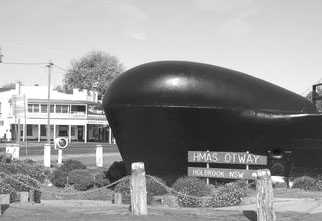- Author
- Wahlquist, Gilbert
- Subjects
- Biographies and personal histories, Ship histories and stories, Post WWII
- Tags
-
- RAN Ships
- HMAS AE2, HMAS Otway II
- Publication
- March 2006 edition of the Naval Historical Review (all rights reserved)
I suppose it is the fantasy of every submariner – up periscope, a quick circuit and there, a cable’s length away – is the local pub.

(Photo: Gil Wahlquist)
Dreams are about to come true at the inland town of Holbrook, New South Wales, which has added a working periscope and the mock-up of a control room to its astounding submarine display. When the periscope is raised it gives a view of the countryside, including what appears to be a real live submarine and the latest addition – a ‘duck’s arse’ – a term to describe the after end of a sub. The installation of the periscope and the duck’s arse was made possible by a grant of $4,000 from the Department of Veterans Affairs and $78,000 from the NSW Department of State and Regional Development.
Ann Redwood, secretary/treasurer of the Submarine Project Committee, proudly invited me to look through the periscope and inspect the duck’s arse, which was having a display board fitted that day.
All this is amazing because Holbrook is on Ten Mile Creek, centre of a farming community 430 kilometres away from the nearest port. Its love affair with submarines grew from a simple patriotic act in 1915 when Germantown, established in 1858, felt the brunt of anti-German feeling and changed its name to Holbrook, in honour of Lieut. N. D. Holbrook VC, a submarine commander who had taken the British submarine HMS BII into the Dardanelles to torpedo the Turkish battleship Messudiyeh. The Shire councillors had read about the brave sailor in the newspapers.
Even in today’s terms BII’s voyage was breathtaking. She had a simple petrol engine and battery power, which limited her speed to six knots under water for one hour. Lt. Holbrook and crew took BII under minefields and after sinking the battleship scraped out along the bottom with a shattered compass, being under water for eight hours, the first submarine to have been down so long. Holbrook, aged 25, was awarded the Victoria Cross and the French Legion of Honour. Each of the 13 crew members received the Distinguished Conduct Medal.
Norman Holbrook was delighted that a town had been named in his honour.
An autographed souvenir program of his civic reception when he visited in 1956 (by then with the rank of Commander) is up for auction on the internet with a suggested value of $100 to $120.
In 1972 a one fifth scale model of BII was dedicated in the town. Commander Holbrook made three visits before his death at Midhurst, Sussex, England, in July, 1976. Such was the affinity between the town and the Holbrooks that in 1982 Norman’s widow Gundela donated his medals to the town.
A link between the town and the RAN submarine squadron grew between 1986 and 1992 when submariners were given Freedom of Entry to the Shire of Holbrook.
The navy gave the fin of decommissioned Oberon class submarine HMAS Otway to the Shire in 1982 and with typical zeal a group of submariners decided to go for a whole ship. Several thousand dollars were raised from the town but it was not enough. The RAN sold the skin of Otway to a scrap dealer. Then out of the blue Gundela gave $100,000 and the committee bought the skin from the scrap yard. It was cut into sections and taken on semi trailers the 530 kilometres from Sydney to Holbrook. A team of unemployed trainees rebuilt it during the New Work Opportunities Program co-ordinated by Billabong Skillshare and Holbrook Shire Council.
The submarine memorial was dedicated during the Queen’s Birthday weekend on 7 June 1997 with Mrs. Gundela Holbrook as the official guest.
Also at the site is a Mark VIII torpedo, commemorating Lieutenant H. Stoker, DSO, RX, and the crew of the RAN Submarine HMAS AE2, in World War I. This had been unveiled by the NSW Governor, Rear Admiral Peter Sinclair, A.O., RAN, Rtd, in 1992.
As a traveler along the Hume Highway over the years I have watched the memorial grow from the model of BII and a torpedo sitting in a park to the first class naval museum that is there today.




